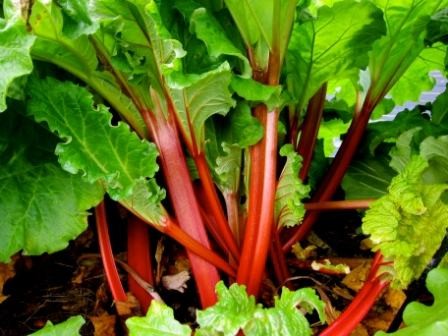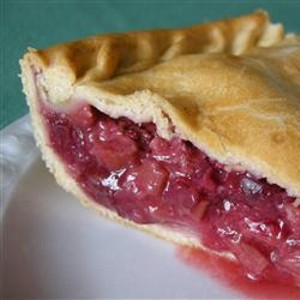It’s coming… Really… Just be patient… In spite of the really hard winter we’ve just experienced in the U.S.Northeast and Eastern Canada, Rhubarb is wakening as we speak, to be the first crop we’ll harvest from our gardens once again this year. And there’s a ton of stuff you can do with it!
 Rhubarb, as it grows in your garden. Some big plants get to be more than
Rhubarb, as it grows in your garden. Some big plants get to be more than
a metre across, given several years in the right conditions…
This remarkable, traditional, readily available vegetable is one of the most underrated and overlooked foods that are native to our climes! Let’s celebrate it this spring with a whole spectrum of recipes reflecting tastes past present and (possibly) future!
What is it, really?
The Rhubarb we cultivate and eat – officially Rheum rhabarbarum – is, more precisely, a group of hybrids of that plant created specifically for human consumption, and optimum flavour and colour. We eat the fleshy stems which are, ideally, ruby red through and through when ripe.
Note: The leaves are poisonous. Garbage them; don’t put them in the composter!
For the record, Rhubarb really is a vegetable, not a fruit – although we generally treat it like a fruit, using it in sweetened dishes, for desserts. Think of rhubarb as a notional cross between Kale or Chard, and Celery. The leaves look as though belong to the former and the stems to the latter.
You can usually get Rhubarb in the supermarkets during the spring in Eastern Canada and the U.S. Northeast. But most folks who like it grow their own. This hardy perennial establishes a strong root network from which new stems and leaves sprout each year. So productive is this plant that many who can’t be bothered growing it get all they want from those who have mature roots growing in their gardens.
A galaxy of Rhubarb applications!
We could start with Rhubarb Pie. Then, go on to a blend of Rhubarb and Strawberries – a Canadian classic. Make Rhubarb Pies the same way you would Apple or Peach Pies. You can use either a one-crust or a two-crust configuration. Pre-heat the oven to 425 F and bake the pie there for the first 15 minutes. Then turn down toe temperature to 350 F and bake for another 45 minutes. This procedure will ensure that the filling is juicy and tender while the bottom crust will not get soggy.
Hint: Anytime you use Rhubarb in a recipe where you’d normally use Apples or other more conventional fruit, remember to add extra sugar to balance off Rhubarb’s extra tartness!
And don’t forget those close cousins of the Pie, Crumbles and Crisps. Just treat the Rhubarb the same as you would tart Apples. Try sugaring down the cut-up rhubarb for half an hour in the fridge before putting together your casserole.
Rhubarb and Strawberry are also a classic combination in the Jam/Compote sector. Cook together with a little water and sugar in a medium-hot sauce pan until the Rhubarb becomes soft and starts to break down and the liquid becomes thick and syrupy. Store as any other Jam or Jelly.
Something a little different…
For a different Summer Salad, try marinating cut-up Rhubarb in a little Maple Syrup, Balsamic Vinegar and a pinch of Cloves and Nutmeg. (Add the Spices to taste.) Toss with Baby Mixed Greens (AKA – Mesclun) and dress with the marinade. No, I’m not kidding.
And that’s just the beginning…
There are dozens of good Rhubarb recipe websites out there – and hundreds of no-so-good ones. Taken together, these three offer sdeveral hundred of the best recipes I’ve seen and the most creative ways to use Rhubarb!
http://www.canadianliving.com/recipe-directory/main_ingredient/rhubarb.php
As you’ll discover, folks use Rhubarb in all kinds of ways – even in Spaghetti Sauce and Chili!
Explore new culinary dimensions…Enjoy Rhubarb this spring!
~ Maggie J.

